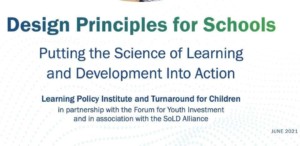The Case for Competency as a New Equity Agenda

By: Tom Vander Ark and Mary Ryerse
We believe that every student deserves a great high school education – one that engages, challenges and inspires them, equips them to succeed in a rapidly changing world, and prepares them to thrive in the jobs of the future. We believe that all students should progress based on mastery and be provided the supports they need to succeed.
However, for more than 125 years, most of the world has relied on time-based proxies of learning. Students move through the system by grade level, some mastering important knowledge, and skills, many moving on with big skills gaps that limit their future potential. Simple to organize and manage, this system has also served to perpetuate and mask social and academic inequalities.
The standards-based reforms of the last 25 years are a very important start. In the best cases, they include high expectations for all students, clear guidelines for what all students need to learn, measurements that highlight underserved students, and extra support for struggling students. Yet they have also been hampered by the bones of a system designed–in structure, staffing, and funding–to move students along in batches rather than as individual, lifelong learners.
What if the system — and schools themselves — were designed with a commitment to equity at the forefront and were set up to help all students achieve at high levels and progress as they demonstrate mastery? What if schools used time differently — to give students schedules and tailored learning that enable them to fill gaps and also accelerate their learning, so that pacing becomes a force for innovation rather than a mechanism for stratifying students? What if students could advance at different rates in different subjects and still spend time with their age cohorts?
Yesterday, XQ released a new report by Getting Smart, Show What You Know: A Landscape Analysis of Competency-Based Education, that investigates the current state of competency-based education in our nation and examines potential opportunities to stimulate innovation, momentum, and impact. XQ’s intention is to help bolster the conversation on how we can transition to a competency system with equity at the center.
Our scan of the CBE landscape revealed five key areas where important changes are happening: model schools and networks, learning tools, students supports, teacher development, and policy.
Global Shift to Demonstrated Mastery
The world of work has already abandoned whole group, time-based training because it is expensive and ineffective. Most career learning is now just-in-time, self-paced, and a combination of mentorship, instruction, and online resources.
In more dynamic job clusters, traditional pedigrees on their own are becoming less important than they were to earlier generations. Job candidates and workers are being asked to demonstrate competence. It’s not only that grades in traditional courses are less meaningful, it’s also because formal education is highly uneven, and degrees don’t necessarily signify mastery of needed knowledge and skills.
The global shift in talent development includes two key components
- Show what you know: demonstrated knowledge and skills, because the skills that matter most to employers are the key to job success.
- Move on when ready: time is flexible, it’s the learning that’s important and there are multiple pathways.
This shift to anywhere, just-in-time, success-focused learning is being driven by a rapidly changing employment and civic landscape. Most jobs are or will soon be augmented by smart tools. There is less hierarchy and more work in teams, but also more freelancing and unstable employment. Everyone is experiencing high change and high diversity. Successful contributors to this changing landscape bring foundational knowledge and fundamental literacies to the table; they must also be original thinkers, generous collaborators, and self-directed, lifelong learners.
The K-12 Shift to Competency with Equity at the Center
Given how quickly talent development is changing and how it’s beginning to change postsecondary learning around the edges (e.g., military, career and technical education, online learning and alternative HigherEd), it seems likely that the shift will come to K-12 education.
We’ve been talking about the shift from time to learning for a long time, and there are signs of movement everywhere. Given the complexity and the gravity of the current system, the shift to competency education is likely to take a generation. The new opportunity for sector leaders and philanthropies is to make the shift happen better and more equitably.
Competency-based education (also called mastery-, performance-, or proficiency-based learning) holds the potential to improve career and life readiness for more young people.
Show What You Know: A Landscape Analysis of Competency-Based Education begins by outlining six reasons the current system has proven resilient:
- It is difficult to be specific about and prioritize what students should learn.
- The transition from the old system is technically challenging for teachers and schools.
- Instructional resources and digital tools (learning platforms, gradebooks) available to teachers were designed for the old system and don’t support their efforts to personalize learning.
- Despite the widespread use of adaptive and curriculum-embedded assessments, a lack of interoperability makes it difficult to combine data from multiple sources to improve learning and make mastery judgments.
- Colleges and parents are familiar with the old system of courses, credits, and grade point averages. While many colleges are beginning to look at better measures of capabilities, there is not a widely adopted competency-based approach to college admissions.
- Current federal and state accountability systems reinforce grade-level grouping and testing.
The report provides an overview of the competency-based landscape and of potential opportunities to stimulate innovation, momentum, and impact. Research included interviews with over 50 sector leaders, an extensive literature review, and dozens of school visits. It uncovered real enthusiasm for the potential of competency-based education, along with lots of frustration around the barriers (described above) and concern about the risk of uneven quality of implementation.
The report outlines some of the critical elements of the path forward, including five recommendations:
- Support new competency-based networks and school models (XQ, NewSchools, and NGLC grantees are a good start).
- Support quality curriculum and assessment tools for competency-based models.
- Invest in high-quality learning platforms for competency-based models.
- Support solutions to technical barriers and design challenges.
- Advocate for room to innovate and for case studies of solutions.
Moreover, as secondary and postsecondary learning options increase and diploma systems become more flexible, young people will need better access to quality guidance. And we need to think in practical terms about how these advances can best be adopted—in real schools, by real educators, students, and families.
The research has also sharpened our focus on the implications of CBE for educational equity. Putting equity at the forefront is essential, and ensuring that competencies do not become “checklists” of sub-skills that never bring students to an integrated mastery of essential skills and knowledge is a key risk. It’s also true that high-quality CBE depends on a level of personalization that will be very difficult to achieve in under-resourced schools, especially in the early days when CBE tools and resources for teachers are under-developed.
Putting equity at the forefront will challenge our collective powers of imagination and invention. It’s not hard to see how students who learn a concept quickly can accelerate their progress in a “show what you know and move on when ready” system. It’s also fairly easy to envision how schools might support students who need more time to master a concept.
What’s more difficult, but absolutely imperative, is imagining how our schools can enable all students to achieve mastery. A new CBE system will need to ensure that students don’t “stall” in their learning, which will mean investing in and developing new ways to challenge, engage, and guide students so they achieve their full potential. We must also take account of the harsh realities faced by young people who are credit deficient, have transferred schools, or have been unable to “move on” for other reasons. In a CBE system, those students can—and must—accelerate their learning so that they don’t fall further behind.
With advances in these areas, we are confident that more young people will leave high school better prepared for college, careers, and citizenship.
We therefore urge the field as a whole to pursue work in the five overarching areas discussed in the report, while continuing to move forward with additional efforts directed at more specific impact opportunities. We also acknowledge that real progress will depend on an ambitious and fundamental rethinking of what graduates need to know and be able to do (the report notes progress on developing graduate profiles with support from groups including Battelle For Kids and KnowledgeWorks), what evidence will be used to demonstrate and assess their learning, and ultimately, how learning will be credentialed. Our research has strengthened our conviction that an effective, equitable CBE system must be built upon a new infrastructure of goals and requirements—thus calling upon us to rethink the high school credential itself.
We hope you will read the report, use it as a tool for encouraging discussion within your community, join in on the #ReThinkHighSchool conversation, and follow along with us as we continue to explore new ways to build momentum toward equitable CBE within our system.
ACCESS THE REPORT
And for more, see recent blogs and podcasts:
- High School & the Future of Work: A Guide for State Policymakers
- Powerful Learning Experiences: Why All Students Deserve Access
- Show What You Know: The Shift to Competency
- Rethinking the High School Credential
- How Better Transcripts Will Improve College Admissions, Employment, and Licensing
- On Becoming Student-Centered and Mastery-Based (podcast with Susan Bell, WLSD)
- Ask About AI: The Future of Learning and Work
- XQ Institute
- Getting Smart
This post was originally published on Education Week.
Stay in-the-know with all things edtech and innovations in learning by signing up to receive the weekly Smart Update. This post includes mentions of a Getting Smart partner. For a full list of partners, affiliate organizations and all other disclosures, please see our Partner page.






0 Comments
Leave a Comment
Your email address will not be published. All fields are required.